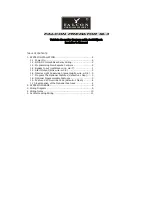
27
26
To keep your Smoke/CO Alarm in good working order,
please follow these simple steps:
• Verify the unit's alarm and LED lights operation by
pushing the test/reset button once a week.
• Remove the unit from mounting bracket and vacuum
the alarm cover and vents with a soft brush attachment
once a month to remove dust and dirt. REINSTALL
IMMEDIATELY AFTER CLEANING AND THEN TEST
USING THE TEST/RESET BUTTON!
• Never use detergents or other solvents to clean the unit.
• Avoid spraying air fresheners, hair spray, or other
aerosols near the Smoke/CO Alarm.
Do not paint the unit. Paint will seal the vents and inter-
fere with the sensor’s ability to detect smoke and CO.
Never attempt to disassemble the unit or clean inside. This
action will void your warranty.
Move the Smoke/CO Alarm and place in another location
prior to performing any of the following:
• Staining or stripping wood floors or furniture
• Painting
• Wall papering
• Using adhesives
Storing the unit in a plastic bag during any of the above
projects will protect the sensors from damage. Do not
place near a diaper pail.
WARNING:
Reinstall the Smoke/CO Alarm as soon as pos-
sible to assure continuous protection.
When household cleaning supplies or similar contami-
nates are used, the area must be well ventilated. The
following substances can effect the CO sensor and may
cause false readings and damage to the sensor:
Methane, propane, iso-butane, iso-propanol, ethyl acetate,
hydrogen sulfide, sulfide dioxides, alcohol based products,
paints, thinner, solvents, adhesives, hair spray, after shave,
perfume, and some cleaning agents.
General CO Information
Carbon monoxide (CO) is a colorless, odorless, and
tasteless poison gas that can be fatal when inhaled.
CO inhibits the blood’s capacity to carry oxygen.
Possible Sources
CO can be produced when burning any fossil fuel: gaso-
line, propane, natural gas, oil and wood. It can be pro-
duced by any fuel-burning appliance that is malfunction-
ing, improperly installed, or not ventilated correctly.
Possible sources include furnaces, gas ranges/stoves, gas
clothes dryers, water heaters, portable fuel burning space
heaters, fireplaces, wood-burning stoves and certain
swimming pool heaters. Blocked chimneys or flues, back
drafting and changes in air pressure, corroded or discon-
nected vent pipes, and a loose or cracked furnace
exchanger can also cause CO. Vehicles and other com-
bustion engines running in an attached garage and using
a charcoal/gas grill or hibachi in an enclosed area are all
possible sources of CO.
The following conditions can result in transient CO
situations: Excessive spillage or reverse venting of fuel-
burning appliances caused by outdoor ambient condi-
tions such as: Wind direction and/or velocity, including
high gusts of wind, heavy air in the vent pipes
(cold/humid air with extended periods between cycles),
negative pressure differential resulting from the use of
exhaust fans, simultaneous operation of several fuel-burn-
ing appliances competing for limited internal air, vent
pipe connections vibrating loose from clothes dryers, fur-
naces, or water heaters, obstructions in, or unconvention-
al, vent pipe designs which can amplify the above situa-
tions, extended operation of unvented fuel-burning
devices (range, oven, fireplace, etc.), temperature inver-
sions which can trap exhaust gasses near the ground, car
idling in an open or closed attached garage, or near a
home.
Carbon Monoxide Safety Information
General Maintenance






































